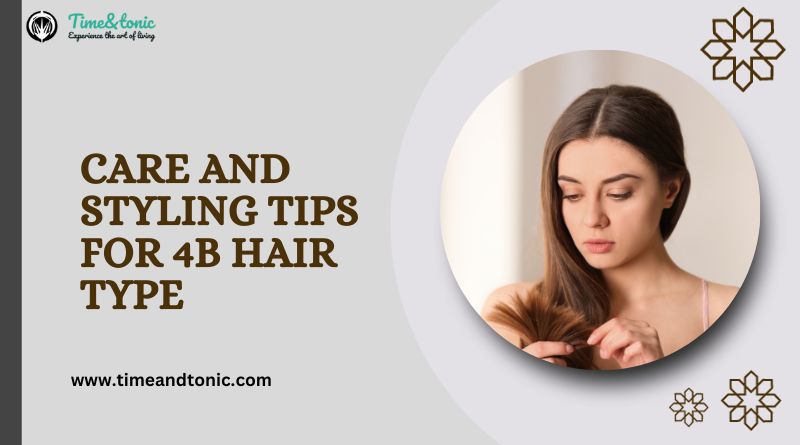Care and Styling Tips for 4B Hair Type
Care and Styling Tips for 4B Hair Type – Welcome to our comprehensive guide on caring for and styling 4B hair type! If you’re part of the vibrant community of individuals with 4B hair, you know that your unique hair texture deserves special attention and love. In this guide, we will delve into the world of 4B hair, discussing its characteristics, dispelling common myths, and providing you with a treasure trove of care and styling tips.
4B hair is characterized by its tight, coiled curls and a distinct “Z” pattern. While this hair type is incredibly beautiful and versatile, it can also be challenging to manage without the right knowledge and techniques. That’s where we come in. Whether you’re seeking advice on maintaining moisture, perfecting your twist-outs, or exploring protective styles, we’ve got you covered.
Embracing your natural hair is a journey, and we’re here to empower you with the information and confidence you need to rock your 4B curls with pride. Let’s dive in and unlock the secrets to healthy, fabulous 4B hair!
What is 4B Hair Type?
4B hair is a unique hair type characterized by tightly coiled, zigzag-shaped curls. It falls under the Type 4 category of hair textures, known for its density and fragility. Unlike other Type 4 subtypes, 4B hair lacks a defined curl pattern and forms a distinct “Z” shape when stretched. This hair type is highly versatile but requires special care and styling techniques to maintain moisture, prevent breakage, and achieve various beautiful hairstyles. Understanding the characteristics of 4B hair is essential for successful care and styling.
Also, Read – Layered Hairstyles to Light Up 2023
Why Does 4B Hair Need Special Care and Styling?

4B hair requires special care and styling due to its unique characteristics and needs:
- Tight Coils: 4B hair features tightly coiled curls with a “Z” pattern. These coils can lead to more tangling and breakage if not handled carefully.
- Frizz-Prone: This hair type is prone to frizz due to the irregular curl pattern. Special care is needed to minimize frizz and maintain a polished look.
- Moisture Retention: 4B hair tends to be drier because natural oils have a harder time traveling down the tightly coiled strands. Adequate moisture retention is crucial to prevent dryness and breakage.
- Shrinkage: 4B hair can experience significant shrinkage, making it appear shorter than it actually is. Understanding how to manage and embrace shrinkage is essential for styling.
- Breakage and Damage: Without proper care, the tight coils of 4B hair can be more susceptible to breakage, especially during detangling and styling.
- Versatile Styling: Despite the unique challenges, 4B hair offers versatility. Learning specialized techniques can help achieve various stunning hairstyles, from defined twist-outs to protective styles.
To maintain the health and beauty of 4B hair, individuals need to adopt tailored care and styling routines that prioritize moisture, minimize manipulation, and cater to its unique needs.
Care and Styling Tips for 4B Hair Type
Moisturize regularly
Moisturizing is crucial for 4B hair. Due to its natural dryness, apply a leave-in conditioner or oil regularly. Look for products containing natural oils like coconut or shea butter. Deep conditioning treatments can restore moisture and strength, reducing breakage. Try co-washing instead of frequent shampooing to retain essential oils. Protective styles such as braids can minimize manipulation and damage.
Detangle gently when wet with a wide-toothed comb or fingers. Trim every 8-12 weeks to maintain health. Limit heat styling, use a protectant, and choose lower heat settings. Sleep with a satin or silk pillowcase or wrap hair in a scarf. Patience and consistency are key to achieving healthy, beautiful 4B hair.
Deep conditioning
Deep conditioning is essential for 4B hair. This hair type tends to be naturally dry, so a regular deep conditioning routine is crucial to maintain moisture and strength. Choose a deep conditioner that’s specifically formulated for textured hair, and apply it generously. Cover your hair with a plastic shower cap or a warm, damp towel to create a “steam” effect, which helps the product penetrate the hair shaft.
Leave the deep conditioner on for the recommended time (usually 15-30 minutes), then rinse thoroughly with cool water to seal the hair cuticles and lock in moisture. Deep conditioning should be done regularly, typically once a week or as needed, to keep your 4B hair hydrated, soft, and healthy.
Co-washing
Co-washing, short for “conditioner washing,” is a beneficial technique for 4B hair. Instead of using traditional shampoo every time you wash your hair, co-washing involves cleansing your hair with a conditioner. This method helps retain natural oils, preventing excessive dryness common with 4B hair.
To co-wash, wet your hair thoroughly, then apply a silicone-free, moisturizing conditioner from roots to ends. Massage your scalp gently with your fingertips to lift dirt and buildup. Allow the conditioner to sit for a few minutes, then rinse thoroughly with lukewarm water.
Co-wash as needed, typically once or twice a week. However, adjust the frequency based on your hair’s specific needs and how often you engage in other styling practices. Co-washing helps maintain moisture, manageability, and overall hair health for your 4B hair type.
Also, Read – Haircuts That Expertly Conceal a Receding Hairline
Protective styles

Protective styles are essential for maintaining the health and beauty of 4B hair. These styles involve tucking away your ends and minimizing manipulation to protect your hair from damage. Examples of protective styles for 4B hair include braids, twists, cornrows, bantu knots, and crochet braids. They shield your hair from environmental factors, reduce tangling and breakage, and help retain moisture.
To maintain these styles, moisturize your hair before installation, and keep your scalp clean and healthy. Avoid wearing the style for too long to prevent tension and breakage. Be gentle when taking down the style to avoid unnecessary damage.
By incorporating protective styles into your hair care routine, you can promote growth and maintain the length and strength of your 4B hair while enjoying versatile and low-maintenance looks.
Low manipulation
Low manipulation hair care is crucial for preserving the health of 4B hair, which can be delicate and prone to breakage. This approach involves minimizing excessive handling and styling to reduce damage and encourage hair growth.
- Gentle detangling: Use your fingers or a wide-toothed comb to detangle hair when wet, coated with conditioner. Start from the tips and work your way up to the roots to prevent breakage.
- Protective styles: Embrace styles like braids, twists, or bantu knots that minimize daily styling and manipulation. These styles also protect your hair from environmental stressors.
- Avoid heat: Limit the use of heat styling tools, such as flat irons and curling irons, to prevent damage. Opt for heat-free styles like bantu knot-outs or twist-outs.
- Regular trims: Trim your hair every 8-12 weeks to remove split ends and maintain healthy ends, reducing the need for excessive styling.
- Satin/silk protection: Sleep on a satin or silk pillowcase or wrap your hair in a satin/silk scarf to minimize friction and breakage during sleep.
Low manipulation helps 4B hair thrive by reducing stress on the strands and promoting overall hair health.
Detangle carefully
Detangling 4B hair requires gentle care to prevent breakage and maintain its natural texture. Here’s how to do it:
- Start when wet: Begin detangling when your hair is wet and conditioned. Apply a detangling conditioner or a mix of water and conditioner to help ease the process.
- Section your hair: Divide your hair into manageable sections using clips or hair ties. This makes the process more organized and less overwhelming.
- Use a wide-toothed comb or fingers: Avoid fine-toothed combs or brushes that can cause damage. Start at the tips of your hair and work your way up towards the roots, gently removing knots and tangles.
- Detangle from ends to roots: Gradually work through each section, releasing tangles as you go. Be patient and avoid pulling or yanking on the hair.
- Add more conditioner if needed: If a section becomes dry or difficult to detangle, apply more conditioner or water to help.
- Consider using detangling sprays: Some detangling sprays or serums can help further ease the process.
Detangling carefully helps prevent breakage and minimizes hair damage, allowing your 4B hair to remain healthy and manageable.
Trim regularly

Regular trimming is essential for maintaining healthy 4B hair. Trims help remove split ends and prevent breakage, promoting hair growth and overall vitality. Here’s how to trim your hair effectively:
- Schedule trims: Aim for a trim every 8-12 weeks, depending on your hair’s condition and styling practices.
- Use sharp scissors: Invest in quality hair scissors or visit a professional stylist to ensure clean, even cuts.
- Start with clean, dry hair: Trimming on dry hair allows for a more accurate assessment of split ends.
- Section your hair: Divide your hair into manageable sections using clips or hair ties for precision.
- Trim the tips: Gently trim the ends of each section, taking off only what’s necessary to remove damaged or split ends.
- Regular maintenance: Continue to follow a healthy hair care routine to minimize future damage and the need for excessive trimming.
Regular trims contribute to maintaining the shape and strength of your 4B hair, ensuring it looks and feels its best.
Use the L.O.C. method
The L.O.C. (Liquid, Oil, Cream) method is a popular approach to moisturizing and sealing in moisture for 4B hair. Here’s how to use it effectively:
- Liquid: Start with freshly washed and conditioned hair. Apply a water-based leave-in conditioner or plain water to provide initial hydration. This step helps to open the hair’s cuticles and prepare it to receive moisture.
- Oil: After the liquid step, apply a natural oil like coconut oil, olive oil, or jojoba oil. This helps to lock in the moisture from the liquid and prevents it from evaporating, keeping your hair well-hydrated.
- Cream: Finish with a creamy moisturizer or hair cream rich in natural ingredients like shea butter or mango butter. This layer seals the oil and water in, creating a protective barrier and ensuring your hair stays moisturized for an extended period.
The L.O.C. method is an effective way to maintain moisture and prevent dryness in 4B hair, promoting softness and manageability. Adjust the products and amounts based on your hair’s specific needs.
Sleep protection
Protecting your 4B hair while you sleep is crucial to prevent friction and breakage. Here are some tips for sleep protection:
- Satin or Silk Pillowcase: Invest in a satin or silk pillowcase. These materials create less friction than cotton, reducing the chances of hair damage.
- Satin or Silk Bonnet: Wear a satin or silk bonnet or scarf to cover your hair while sleeping. This keeps your hair in place and minimizes friction.
- Pineapple Method: Gather your hair at the top of your head, loosely securing it with a satin scrunchie or hair tie. This helps preserve your hairstyle and prevents tangling.
- Silk or Satin Sheets: If you prefer to sleep without a bonnet or scarf, consider silk or satin sheets to reduce friction against your hair.
By incorporating these sleep protection techniques, you can maintain the health and style of your 4B hair while getting a good night’s rest.
Conclusion
In conclusion, caring for and styling 4B hair is an art that requires patience and knowledge. Embrace your unique curls, and remember that your hair is a reflection of your beauty and individuality. With the right techniques, products, and self-love, you can confidently rock your 4B hair in various stunning styles.
This journey is about celebrating diversity and empowering yourself to shine. So, go forth with confidence, experiment with styles, and keep exploring the wonderful world of 4B hair. Your beauty is boundless, and your curls are your crown.
FAQs
Moisturizing 4B hair involves using a leave-in conditioner or moisturizer to provide hydration. Additionally, sealing in moisture with natural oils like jojoba or castor oil can help lock in the moisture and prevent dryness.
It’s generally recommended to wash 4B hair every 1-2 weeks. However, the frequency can vary depending on your hair’s needs and lifestyle factors. Avoid overwashing, as it can strip the hair of its natural oils.
Look for products designed for curly and coily hair, such as sulfate-free shampoos, deep conditioners, and leave-in conditioners. Experiment with different products to find what works best for your hair’s unique needs.




